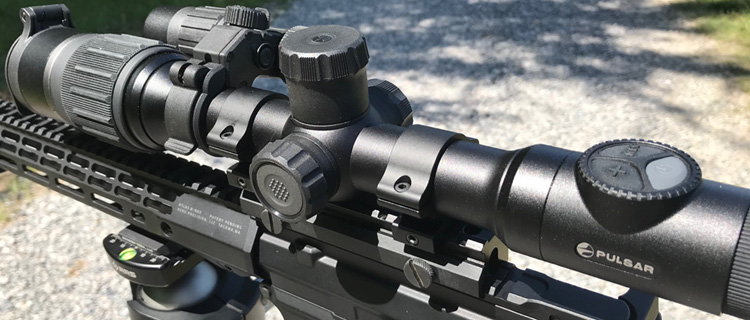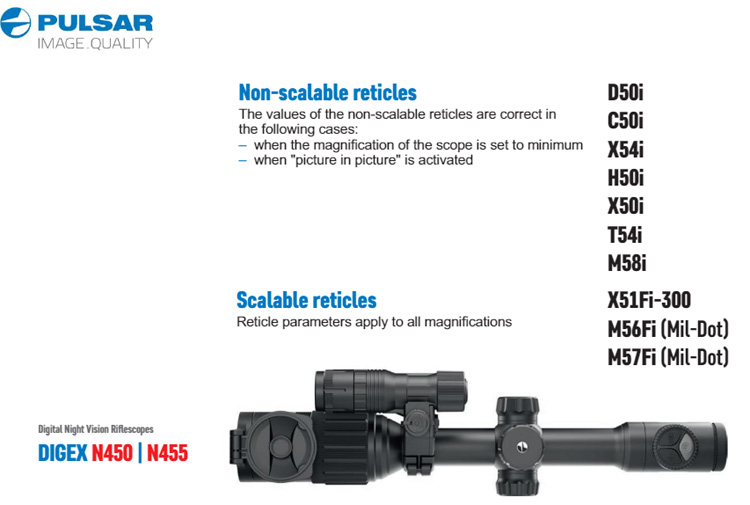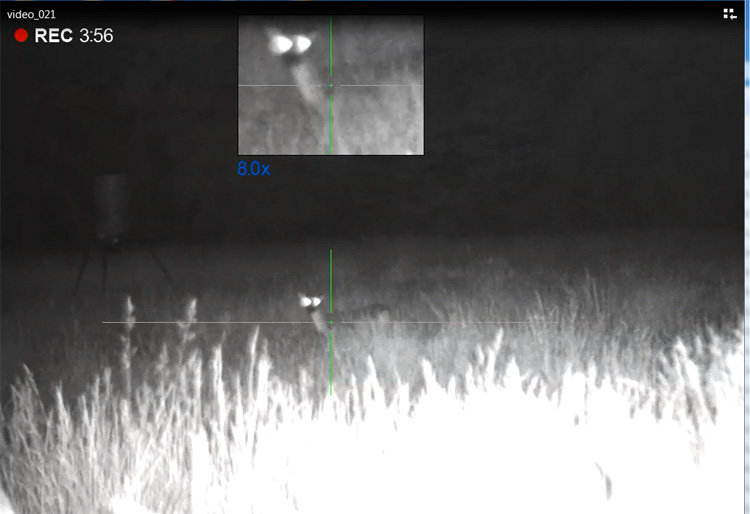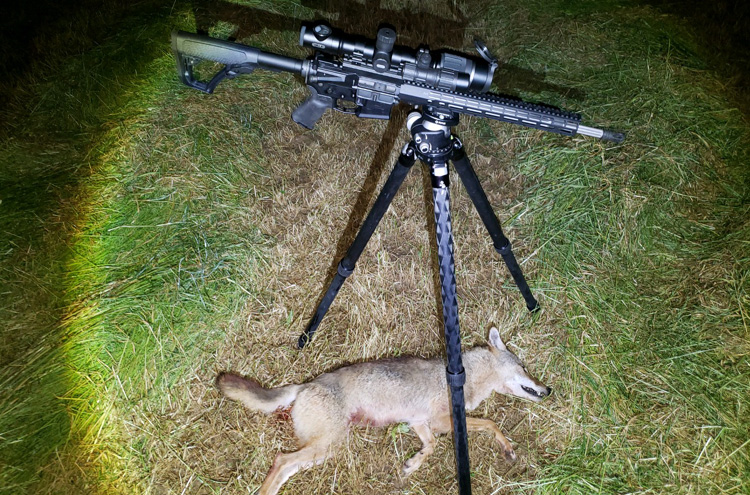Pulsar Digex N450 Digital Night Vision Rifle Scope Review
The Pulsar Digex N450 is Pulsar’s newest digital night vision riflescope for 2020. The Digex N450 is a 4-16X digital night vision riflescope that gives you the best digital night vision technology on the market in a standard size 30mm tube. All those problems of mounting a night vision scope on your bolt action style rifle have gone away, plus you get a host of features normally reserved for Pulsar’s thermal scopes. Two of my biggest surprises were long battery life and the quality of the included IR illuminator.
Pulsar Digex N450 Features

The Digex has a base power of 4x, a 1280×720 HD imaging sensor, and a 1024×768 HD AMOLED display screen that combined offer an excellent day or nighttime image. The built-in recorder captures still images and HD quality videos with sound. It has 16 gigabits of internal storage and videos can be downloaded directly to your computer via USB cable or to wireless mobile devices through the Stream Vision application. Stream Vision also allows the streaming of the image to a smartphone. The dual rechargeable Pulsar APS battery pack system is used in the scope, and a single APS2 battery powers the IR illuminator. The Digex has five rifle zeroing profiles, and you can choose between 10 reticles in 8 color options. Bad weather is not a problem because it is fully waterproof and will operate in temperatures down to -13F.
Digex Premier Features
- 1280×720 HD imaging sensor
- 1024×768 HD AMOLED display screen
- A selection of 10 reticle shapes in 8 color modes
- Instant start-up & standby mode
- Integrated video and sound recorder
- Picture in Picture Aiming
- 1-shot zeroing
- Rechargeable Battery System
- 5 individual shooting profiles/50 zeroing distances
- Software sensitivity enhancement algorithm SumLight
- Customizable automatic shutdown
- Stadiametric rangefinder
- Side incline indication
- IPX7 Weather Rated
Digex N450 Battery System
 The N450 is powered with an internal non-removable APS3 battery and also a removable Pulsar APS2 rechargeable battery. The built-in battery is housed in the tube and the other removable battery is located in a battery compartment where the elevation turret is normally located on a conventional scope. When the replaceable battery is completely discharged, the riflescope switches automatically to the built-in battery. The replaceable battery can be removed and replaced in a matter of seconds. If all battery power is exhausted, the scope can be powered from an external power source via a mini-USB port on the side of the scope. The included IR light is powered by a separate APS2 battery. A longer lasting Pulsar APS3 battery may also be used in the Digex and can be ordered separately, as can extra APS2 batteries.
The N450 is powered with an internal non-removable APS3 battery and also a removable Pulsar APS2 rechargeable battery. The built-in battery is housed in the tube and the other removable battery is located in a battery compartment where the elevation turret is normally located on a conventional scope. When the replaceable battery is completely discharged, the riflescope switches automatically to the built-in battery. The replaceable battery can be removed and replaced in a matter of seconds. If all battery power is exhausted, the scope can be powered from an external power source via a mini-USB port on the side of the scope. The included IR light is powered by a separate APS2 battery. A longer lasting Pulsar APS3 battery may also be used in the Digex and can be ordered separately, as can extra APS2 batteries.
The battery life of the Digex during our bench testing was very good. For the test, I turned it on and let it run without any interruptions. The temperature was about 60 degrees. The scope ran for 6 straight hours on a single charge of the internal APS3 and an APS2 battery in the top compartment. The IR light battery lasted for 5 hours. I did no recording or internal scope changes during this time. The IR light was set at the brightest setting. That is a better battery life than I have experienced with the Thermion Thermal scope using the same battery system.
Pulsar Digex 850nm detachable IR Illuminator
 The Pulsar 850nm detachable IR Illuminator that comes with the Digex N450 is a very good light for hunting out to at least 200 yards. It has an easy-to-reach power button and a rheostat knob to increase the power from low to high. It did not seem to increase power gradually but just went from a low setting to high very quickly. I turned it to the highest setting and left it there. There is a warning light in the power button that turns red when only 30 minutes of power remains in the battery. The video below shows the effectiveness of the stock illuminator at 100 yards.
The Pulsar 850nm detachable IR Illuminator that comes with the Digex N450 is a very good light for hunting out to at least 200 yards. It has an easy-to-reach power button and a rheostat knob to increase the power from low to high. It did not seem to increase power gradually but just went from a low setting to high very quickly. I turned it to the highest setting and left it there. There is a warning light in the power button that turns red when only 30 minutes of power remains in the battery. The video below shows the effectiveness of the stock illuminator at 100 yards.
The Digex IR illuminator is not permanently mounted to the scope. It clamps on via a QD mount and it can be rotated around the tube to the left or right side or taken off completely. The light has adjustments for aiming the beam and can then be locked into place. A key feature Digex IR illuminator is missing is the ability to focus the beam from a wide flood pattern to a narrow beam of light for long shots. If you decide to use an aftermarket IR, you can remove the Pulsar Illuminator to save weight and have a spare battery for your scope.
There are two Pulsar IR Illuminators that the Digex can be purchased with. The Digex N450 comes with an 850nm illuminator and the Digex 455 comes with a 940nm illuminator. The 850nm IR gives you longer range but gives off a soft red glow when you look into the lens of the light. The 940nm IR is totally invisible but has a much shorter range. Most people choose the 850nm illuminator because they can see farther and wild game pays little attention to the soft red glow.
Pulsar Digex Scope Controls

Digex Controller Knob on the left side of the scope, Power, Magnification/Record Buttons on top of the eyepiece
The Pulsar Digex N450 controls are easy to use and conveniently located. If you are familiar with the Pulsar Thermion, the controls are basically the same. The controls used most often during a hunt are the power, record, and magnification buttons which are located on the top of the scope above the eyepiece. The power/record/magnification buttons are laid out in a triangle grid within a small circle that makes it easy to operate at night for most users. Even if you are wearing gloves, they are pretty easy to use.
Other controls like adjustments for brightness, reticle changes, and contrast are accessed through the controller knob on the left side of the scope. All menu functions must be accessed through the controller knob. There are four quick functions that can be accessed through the controller while hunting; brightness, contrast, range profile & range estimation functions. The stadiametric range estimation function uses a pair of lines to bracket the target and estimate range, not a laser range finder. This feature offers very limited accuracy and generally should not be relied upon. If you have more than one zeroing distance saved in a rifle profile, it can also be accessed and changed in the quick functions.
The focus ring is in the same place as a regular riflescope with an adjustable objective on the front of the scope. It has a wide rubber covered adjustment ring that is easy to access with the non-shooting hand and has a firm, but smooth rotation. The flip-up lens cover is made of hard plastic and does a good job keeping dust off the lens. Be careful not to let the opened cover block the IR light.
Pulsar Digex Ballistic Reticles

The stadiametric range function of the Digex is a little slow to use in the field on game like coyotes or bobcats, but Pulsar has you covered. All of the reticles can be used at base power or in the picture-in-picture window for range estimation and hold-over. Three of the reticles (X51Fi-300, M56Fi, M57Fi) have “Smart Reticle Function”. When the digital zoom is changed, the reticle that is displayed on the display is scaled, i.e. its view will change (increase or decrease) in proportion to the variable magnification. This allows the use of ballistic reticles with any digital zoom power. This function is similar to a conventional front focal plane scope with a ranging reticle, ie, it ranges properly at any power. Download the Digex Reticle Catalog for more information.
Picture-in-Picture Display – Pulsar Exclusive

Picture-in-Picture Display
The Picture-in-picture displays a magnified image at the top-center 10% of the overall field of view for precise shot placement. The smaller display window increases magnification as you zoom the digital power button and the larger bottom portion of the display remains at base magnification. This picture-in-picture feature is one of the most popular functions of Pulsar Scopes. The feature works very well and usually takes away the need to fumble with the zoom button right before the shot.
Because the Digex has a base magnification of 4x, I found the picture-in-picture not to be needed as much as a scope like the Thermion XP38 with the low 1.5x base power. But even with a 4x base magnification, when that coyote hangs up at 250 yards, that little picture-in-picture window at 8-16x allows for much better aiming for that long shot. The larger picture gives you a wide field of view and clear image and you have the small window for precise aiming.
Another good thing I discovered is that using the picture-in-picture function removes some of the light reflection that you see in the full image view. In the photo above you can see the reflection I was getting from the tall grass, but the small magnified window has much less light reflection.
SumLight Software
The Digex uses SumLight software to increases sensor sensitivity which allows passive observation (without IR) in low light conditions and at night. The software automatically activates algorithms (such as summing adjacent pixel signals, frame addition), thus increasing sensitivity while preserving good image quality.
What this means is that you get great image quality at dusk and dawn even without the IR, and at night it uses any ambient light to boost the IR illuminator for better image quality. With a quarter moon last night, I could see cows, deer feeders, and the top of tree line without the IR illuminator.
One-Shot Zeroing
The “one-shot” zeroing function lets you fire a shot on target, then hold a crosshair on the aiming point while you move a second reticle to the shot. I had to use a few shots instead of one, but the process is easy, and each profile has yardage and reticle coordinates displayed. When zeroing and setting rifle profiles, you can select the reticle shape, reticle color, and pallet color along with your zero coordinates. Reticle selection runs from simple crosshair to ranging reticles in several colors.
The Digex N450 has five weapon zeroing profiles and 10 settings for yardages within each profile. You can move between profile settings by using a long press of the controller knob, followed by turning the knob to the desired setting. The selected profile is shown on the display screen. If you have more than one distance setting in a profile, the yardages can be quickly accessed using a short push of the controller knob and turned to the desired distance setting.
Hunting With The Digex N450 Riflescope

Hunting with the Pulsar Digex N450 is an exciting experience. It is quite a thrill to break through the darkness with the Digex’s sharp digital image and see how much wildlife is roaming the night. For my review, I wanted to use the Pulsar illuminator and I was not disappointed. The Pulsar IR illuminator was adequate for my hunting situations within 200 yards. Of course, more light is better, and to get the full potential of the Digex, an illuminator like the Sniper Hog Light is a must.
On my first night out hunting for hogs, I found a small sounder and was able to put a good shot on one of the large sows. The challenge of the shot was the trees I had to shoot through. With digital night vision scopes, there is usually a problem with the light reflection from leaves and brush in the foreground that makes it difficult to actually see through the trees. Yes, there was a reflection from the trees, but I was still able to see the hogs that were 50 yards beyond the trees for a good shot.
The Pulsar Digex N450 is not advertised as a daytime scope because unlike the Sightmark Wraith, it does not have a full-color mode for hunting during the day. While the Digex can be used during the day in its normal black and white mode, it's not ideal and you won't want to replace your traditional daytime scope with the Digex. A feature it does have is a small center lens in the dust cap that shades harsh light and aids in clarity when it is used during daylight hours. This feature helps you when zeroing the scope or hunting during the day. Although the image is always black and white, it is clear. In the range photo below, I am aiming at the 50-yard target and you can see clearly back to the 200-yard target.

Since we are talking about the Wraith, I have to mention the field of view, a specification that is so critical for rifle scopes. Both the Digex and the Wraith have 4x base magnifications, so you might assume the field of view is about the same. The field of view of the Wraith is only 21 feet wide 100 meters, about the same as the typical standard 4x rifle scope. The field of view of the Digex at 100 meters is 34 feet wide. That means your viewing area of the Digex is 60% wider than the Wraith. That extra width calculates into over twice the square feet of viewing area in the image at 100 yards.
The reticles on the Digex are not only different colors and shapes, but they are sized properly for precise aiming. The cross or dot in the center of the reticle does not cover a large area for long shots. There are several combinations of colors and reticle shapes. I am sure you will find one to your liking.
The Digex N450 Does Everything Right
If you are looking for a great digital night vision scope, look no farther. The Pulsar Digex N450 has a great image, generous field of view, and adequate IR illuminator. It may not be the best choice if you want to use it a lot for daytime hunting, but for night hunting, it can't be beaten.
The Pulsar APS2/3 battery system is sufficient for 4-5 hours of hunting time which is enough for most hunters, and a couple of spare batteries or USB power bank will get you through a longer hunt. The IR light is adequate for most hunting situations, but can only be powered with APS2 batteries. If you are hunting larger fields, I would recommend adding a Sniper Hog Light 66LRX (that uses inexpensive rechargeable 18650 batteries) to your purchase and use the extra Pulsar APS2 battery for your scope.
I have no dislikes about the Pulsar N450 night vision scope. The controls used most often during a hunt are conveniently located and easy to operate. It powers up in 5 seconds and has a power-saving standby mode. It did everything well, functioned perfectly, and I highly recommend it.
Pulsar Digisight Ultra LRF Night Vision Scope

The Pulsar Digex N450 is a great digital night vision scope, but there is another great Pulsar night vision option, as well. Pulsar also offers the Digisight Ultra and the Digisight Ultra LRF (laser range finder) night vision scopes based on their popular Trail Series of scopes. The non-LRF model will be phased out of the US market in the summer of 2020.
The Pulsar Digisight Ultra 4.5×18 series offers all the features of the Digex, except it is housed in the Trail body instead of the Thermion body and uses the IPS 5/10 battery packs. If you are a fan of the Pulsar Trail series or want the much longer-lasting IPS battery packs, you may want to consider the Digisight. Only the Digisight offers a laser range finder option for night vision riflescopes.
The controls are different and it is more difficult to mount on a bolt action rifle, but if you use any other Pulsar units with IPS battery packs, it may be the best option for you. The Digisight battery packs will run 2-3 times longer than APS2/3 series batteries on a charge.
Night Vision Scope Prices
Pulsar Digex N450/N455 $1199.97
Pulsar Digisight Ultra $1299.97
Pulsar Digisight Ultra LRF $1499.97
Digital Scanner & Night Vision Scopes
If you are new to hunting at night something you need to understand is the importance of a thermal scanner/monocular. Before you can shoot a hog or coyote at night, you have to locate them. As good as the Digex is, it is very hard to locate a coyote that may be coming in from any direction using only your scope. A scanner is a must unless you are sitting over a feeder or bait pile waiting for your game.
On my last hunt, I was in tall grass in a hayfield where reflection was a problem. With my AGM TM35-284 thermal scanner, I could see several deer in the field from 75-150 yards out. The only thing I could see with the night vision scope was their eyes when they were looking at me. You can now buy thermal scanners for about the same price as the Digex, so I urge you to consider a digital scanner along with the scope to make your hunts more enjoyable and successful.

Visit our Outdoor Legacy store to purchase the Digex N450, Digisight Ultra, Sniper Hog Light, or other quality thermal optics. If you have questions, please call Jason Robertson at (877)350-1818.
Also please visit Outdoor Legacy on Youtube and HansETX for great hunting videos and thermal optic reviews.
If you’re looking for great reviews and commentary on the latest in the night vision and thermal industry be sure to tune into The Late Night Vision Show, a weekly podcast hosted by Jason Robertson and HansETX.
